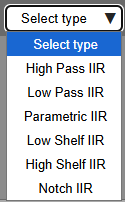- 03 Dec 2025
- 2 Minutes to read
- Print
- PDF
Components - Equalizers
- Updated on 03 Dec 2025
- 2 Minutes to read
- Print
- PDF
Equalizers and filters are essential tools in audio processing that manipulate frequency response to enhance sound quality by boosting or cutting specific frequency ranges and eliminating unwanted noise.
Equalizer 5-band
A 5-band equalizer (EQ) allows users to adjust the balance of specific frequency ranges (or bands) within the audio signal. In a 5-band EQ, the frequency spectrum is divided into five adjustable bands, each targeting a different range of frequencies. This lets users fine-tune the audio by boosting or cutting specific frequencies to achieve the desired sound quality.
.png)
Five Frequency Bands: The equalizer provides control over five distinct frequency ranges with the center frequencies listed on the component.
Equalizer 10-band
A 10-band equalizer gives you more precise control with 10 adjustable bands.
.png)
Advanced Equalizer
Customize your equalizer upon needs by combining different equilizer types:

Hint!
These equilizers can also be used individually as descirbed below.
To access the configuration, click the gear icon
 in the top-right corner of your new component.
in the top-right corner of your new component.Select the equilizer type you wan to use, you can choose from:
High Pass IIR
Low Pass IIR
Parametric IIR
Low Shelf IIR
High Shelf IIR
Notch IIR.
Configure the equilizer.
To add more equilizers, use the plus icon
 or x icon to remove one.
or x icon to remove one.Return to your design with the x icon or click on the Design tab.
.png)
High Pass IIR
This filter allows high-frequency signals to pass through while attenuating (reducing) frequencies below a certain cutoff frequency.
.png)
TIP!
To enter the exact parameters, click on the parameter in the right panel of the component and then enter the required value.
High Shelf IIR
This filter is a type of audio filter that allows frequencies above a certain cutoff frequency to pass through while boosting or attenuating all frequencies above that cutoff point. It is designed to adjust the overall tonal balance of audio signals, particularly for enhancing the high frequencies.
.png)
Low Pass IIR
Is a type of audio filter that allows low-frequency signals to pass through while attenuating (reducing) frequencies above a certain cutoff frequency.
.png)
or
.png)
Low Shelf IIR
Is a type of audio filter that allows frequencies below a certain cutoff frequency to pass through while boosting or attenuating (reducing) all frequencies below that cutoff point.
.png)
Parametric IIR
Is a peaking audio filter that allows for precise control over a specific frequency band.
.png)
Notch IIR
Is a specialized audio filter designed to attenuate (reduce) a very specific frequency or a narrow band of frequencies while allowing other frequencies to pass through relatively unaffected.
.png)
Custom FIR (Finite Impulse Response)
Refers to a type of digital filter where the user can define its characteristics and behavior to meet specific audio processing needs. FIR filters are used for their inherent stability and linear phase response, making them suitable for various applications in audio processing, such as equalization, filtering, and signal shaping. .png)
To define your custom FIR, we recommended to use a filter design tool as for example MATLAB, Python’s SciPy library or a dedicated FIR filter design tool. These tools usually allow you to input parameters like filter type, order, and cutoff frequencies. The tool will output a list of coefficients that represent the impulse response of the filter.
Define Filter Requirements:
Filter Type: Determine the type of filter you need (e.g., low-pass, high-pass, band-pass, or band-stop).
Cutoff Frequencies: Set the cutoff frequency (or frequencies) where the filter will start to attenuate the signal.
Filter Order: Decide the number of taps (coefficients) for the filter. Higher order filters provide more precise control but require more processing power.
Sampling Rate: Specify the sampling rate of the audio signal, as it affects the calculation of the filter coefficients.

